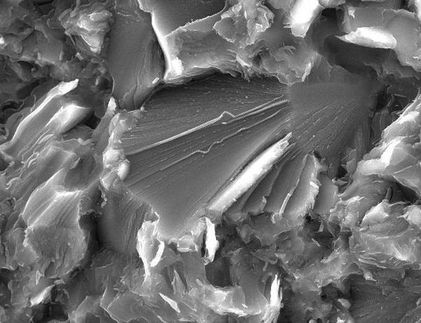Atoms of a glass jump similarly to cosmic particles
X-ray experiment shows possible novel route for tailoring properties of glasses: “The story appears to be getting more interesting”
For thousands of years, people around the world have experimented with different ways to make glasses with varying properties by heating them until they melt then cooling them again. A team led by scientists at the University of Padua in Italy have used DESY’s PETRA III X-ray light source to study a completely different concept: using X-rays to alter the glass without heating it up. The results show that the atoms in the glass move more similarly to charged particles accelerating in interstellar space rather than the motion expected in molten glass. The study may enable a better understanding of irradiated materials or even new glass materials with new physical characteristics, as the research team reports in the journal Proceedings of the National Academy of Sciences (PNAS).

Common annealing of glass uses heat to melt it and afterwards some variation of cooling to set specific properties in place. The experiment using X-rays shows that completely other properties could come from non-thermal annealing.
pixabay.com
Glass is a strange state of matter: Although it looks like a solid, it lacks the typical crystal atomic structure seen in most other solids. Moreover, the atoms remain stuck in their position; they do not diffuse in the material as in a liquid. Glasses can have a variety of physical properties. The process for changing the properties of glasses, called annealing, involves repeated heating of the glass until it acts more like a liquid, then cooling it at various speeds. This is most famously seen with glassblowers: They dip a glass bulb into a fire, change its shape while molten using their breath, and douse it in cold water when finished. Depending on the length of time and temperature of the heating and cooling used, many different kinds of glasses can be made: ones that are super strong, others that break into dull edges, more that can withstand high temperatures, and myriad other possibilities.
The researchers determined a way to get a similar effect to traditional annealing of glass using X-rays. By exposing thin slices of silica (SiO2) to the X-rays generated by the PETRA III light source at DESY and examining changes to the material, the team was able to monitor the atomic motion within the sample. The results differed from what happens when the glass is simply heated and melted – instead of the atoms flowing around one another at a consistently faster rate, in the irradiated sample, some of the atoms tended to make comparably giant leaps within the material. The X-ray process occurred without the glass changing temperature.
Giulio Monaco, a professor at the University of Padua who led the research, describes the difference in atomic motion: “With traditional glass annealing, it’s as if the atom in the glass were a tourist in some place, going around and seeing the sights. With the X-rays on the glass, the tourist – our atom – gets on a plane and goes to a whole other city and starts seeing the sights again.”
“This effect can be used as a probing tool to get deeper knowledge about how the atoms in glasses move,” says DESY scientist Michael Sprung, beamline manager in charge of the experiment station P10 at PETRA III where the research took place and a co-author of the paper. “Our team realised that X-rays caused measurable differences between the observed and expected dynamics. Now there’s a deeper understanding of the effect itself.”
Francesco Dallari, a first author on the study, says that the jumps are caused by the X-rays breaking the bonds between silicon and oxygen in the silica glass. This is caused by the atoms’ electrons being excited by the X-rays and the atoms thereafter repelling one another with great force within the unstructured form of the glass, a phenomenon that is literally somewhat out of this world. The same effect, called stochastic atomic acceleration, is observed in cosmic particle acceleration in interstellar bodies like black holes – but on an utterly massive energy and distance scale compared to the atoms in the glass.
Understanding the effect of X-rays on glass could open the door for many new and heretofore unknown properties of glasses to be discovered. “This research shows that one can tailor the properties of glasses with radiation as opposed to heat,” says Dallari, who was a postdoc at DESY at the time of the experiment and is now in Monaco’s group in Padua. “Depending on the application, glasses might need to be cooled or quenched quickly. Using the X-rays would be like a super-fast quenching.” What sorts of properties this would provide in different situations will be the topic of future research. In the example used in this experiment, the glass became more brittle, but other changes in glass composition, X-ray energy, and time of exposure could produce completely different effects.
“This result could influence how the fatigue of irradiated materials is interpreted, for example,” says Sprung. This could also have a strong effect on a wide range of use cases, such as in medical equipment or in research facilities.
Monaco’s team has a European Research Council grant to investigate this phenomenon and will continue its work at DESY.
“This is only the first example,” Monaco says. “The story appears to be getting more interesting.”
Scientists from the universities of Padua, Trento and Amsterdam as well as from DESY were involved in this work.





























































